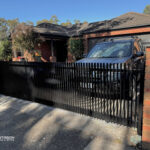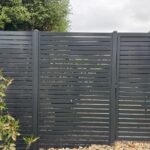Timber fencing is a timeless choice for property owners looking to enhance privacy, security, and aesthetics. Whether you’re enclosing a backyard, defining property boundaries, or adding a decorative touch to your landscape, timber fencing offers a versatile and natural solution. However, with numerous timber species, styles, and installation options available, choosing the right timber fencing can be a daunting task. In this comprehensive guide, we’ll explore the key factors to consider when selecting timber fencing for your property.

timber batten fencing
1. Purpose of Installing Fencing
Identifying the primary purpose of your timber fencing is essential for selecting the most suitable option. Whether you’re looking to enhance security, define property boundaries, create a visual barrier, or add decorative accents to your landscape, understanding your fencing objectives will guide your decision-making process.
If security is a primary concern, opt for tall, solid-panel fences with sturdy construction and secure locking mechanisms. For decorative purposes, explore ornamental fencing styles with intricate designs and embellishments. Consider how your timber fencing will integrate with existing landscaping features, outdoor structures, and architectural elements to achieve your desired outcome.
2. Level of Privacy

Privacy is a crucial consideration for many homeowners when selecting timber fencing. The level of privacy provided by the fence depends on factors such as fence height, spacing between boards, and design features. Solid panel fences or closely spaced picket fences offer maximum privacy by blocking sightlines and reducing noise transmission.
Alternatively, open slat or lattice panel designs provide partial privacy while allowing light and airflow to pass through. Consider your privacy needs and preferences when choosing the style and configuration of your timber fencing. Discuss options with your fencing contractor to find a solution that balances privacy requirements with aesthetic appeal and functionality.
3. Budget
Setting a realistic budget is essential when choosing timber fencing for your property. Your budget will influence various aspects of the fencing project, including the type of wood, fence height, design features, and installation method. Before finalizing your budget, consider factors such as material costs, labor costs, and any additional expenses for maintenance or repairs.
The total cost of timber fencing includes not only the upfront expenses for materials and installation but also long-term maintenance and repairs. Timber fencing costs can vary depending on factors such as the type of wood, fence height, design complexity, and quality of materials.
Softwood species like pine and spruce are generally more affordable than hardwoods like cedar and redwood. However, hardwoods often offer superior durability and aesthetics, which may justify the higher initial investment. Additionally, consider the cost of ongoing maintenance, such as staining or sealing, when evaluating the overall affordability of timber fencing options.
When setting a budget for timber fencing, take into account all associated expenses, including material costs, labor costs, and maintenance expenditures. It’s essential to strike a balance between upfront affordability and long-term value to ensure you get the most out of your investment.
4. Materials for Timber Fencing

Redwood
The choice of timber materials is a fundamental aspect of selecting timber fencing. Different timber species offer varying levels of durability, aesthetic appeal, and resistance to decay. Common timber species used in fencing include pine, cedar, redwood, spruce, and hardwoods like oak and teak.
Softwoods like pine and spruce are popular choices for their affordability and availability, but they may require more frequent maintenance to protect against decay and weathering. Hardwoods such as cedar and redwood are prized for their natural beauty, durability, and resistance to decay, making them ideal for outdoor applications.
In addition to timber species, consider the quality and grade of the timber materials used in fencing construction. Choose high-quality timber sourced from reputable suppliers to ensure superior performance, longevity, and aesthetic appeal. Avoid lower-grade materials that may be more prone to defects, warping, or deterioration over time.
Read more: Cedar vs. Pine Fence: Which Is Better For Your Home
5. Colors of Timber Fence

The natural color and appearance of timber can significantly impact the overall aesthetics of your fencing. Timber species exhibit a range of hues, grain patterns, and textures, offering ample opportunities for customization and visual enhancement. Consider the natural color of the timber species when selecting fencing materials, as well as options for staining, painting, or sealing to achieve your desired look.
Softwood species like pine and spruce typically have a lighter, more uniform color, while hardwoods like cedar and redwood boast richer tones and distinctive grain patterns. Explore different staining or painting techniques to customize the color of your timber fencing and complement your property’s architectural style and landscaping.
When choosing a color for your timber fencing, consider factors such as the surrounding environment, existing outdoor features, and personal preferences. Opt for a color that harmonizes with the natural landscape and enhances the overall curb appeal of your property.
6. Styles of Timber Fencing
Timber fencing comes in a wide range of styles and designs to suit various aesthetic preferences and functional requirements. From classic picket fences to modern horizontal slat designs, there’s a timber fencing style to complement any property. Consider the architectural style of your home, as well as the surrounding landscape and outdoor decor, when selecting a fence style.
Traditional timber fencing styles like picket fences, split rail fences, and post-and-rail fences evoke a timeless, rustic charm that enhances the character of your property. Contemporary designs such as horizontal slat fences, vertical board-on-board fences, and lattice panel fences offer a more modern and streamlined look that complements contemporary architecture.
When choosing a fence style, take into account factors such as fence height, board spacing, post design, and decorative elements. Work with your fencing contractor to explore different style options and customize the design to meet your specific preferences and requirements.
Read more: Discover 6 Stylish Wood Fence Idea for Your Home

7. Installation Requirements and Expertise
The installation method and expertise required can vary depending on the type of timber fencing chosen. While some homeowners may opt for DIY installation to save costs, others may prefer hiring professional fence contractors for a hassle-free and precise installation. Consider factors such as terrain, soil conditions, and local building codes when planning the installation of timber fencing.
If opting for DIY installation, ensure you have the necessary tools, skills, and knowledge to complete the project safely and effectively. Follow manufacturer guidelines and best practices to ensure the fence is installed securely and meets all structural and regulatory requirements.
8. Maintenance Requirements
Maintenance is a critical factor to consider when choosing timber fencing, as it directly impacts the fence’s longevity and appearance. Different timber species require varying levels of maintenance to protect against decay, rot, and weathering. Softwoods like pine may require regular sealing, staining, or painting to maintain their integrity and prevent moisture damage. Hardwoods such as cedar and redwood are naturally more resistant to decay but may still benefit from periodic maintenance to prolong their lifespan.
Before selecting timber fencing, assess your willingness and ability to commit to ongoing maintenance tasks. Consider factors such as the climate, exposure to sunlight, and local environmental conditions, as these can affect the frequency and intensity of maintenance required. Opting for low-maintenance timber species or pre-treated materials can help minimize maintenance efforts while ensuring the fence remains in optimal condition for years to come.
10. Regulatory Compliance and Neighborhood Guidelines
Before installing timber fencing, it’s essential to check local building codes, zoning regulations, and neighborhood guidelines to ensure compliance with legal requirements. These regulations may dictate fence height limits, setback distances from property lines, and restrictions on fence materials and designs. Failure to comply with these regulations could result in fines, removal orders, or legal disputes with neighbors.
Additionally, consider consulting with neighbors or homeowners associations (HOAs) if applicable to address any concerns or restrictions regarding fence installation. Collaborating with neighbors and obtaining necessary approvals can help prevent conflicts and ensure a smooth installation process.
Conclusion
Choosing timber fencing requires careful consideration of various factors, including durability, maintenance requirements, cost, aesthetic appeal, environmental impact, installation requirements, and regulatory compliance. By assessing these factors thoughtfully and weighing the pros and cons of different timber species and styles, you can select a fencing solution that meets your needs, enhances your property, and stands the test of time. Whether you prioritize durability, aesthetics, sustainability, or regulatory compliance, there’s a timber fencing option available to suit your preferences and budget.
Decided to hire experts for your fencing project? Contact Pentagon Fencing & Gates one of the most experienced timber fence installers in Melbourne, to determine if a wooden fence is right for your property.




